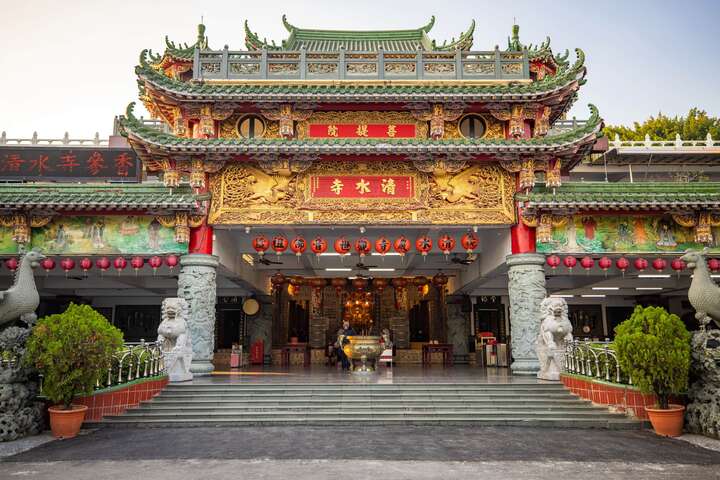Qingshui Rock Scenic Area (Linyuan Qingshui Temple) Introduction
Qingshui Rock is located in the Tan Tou Village of Lin Yuan District, and the entire area is dotted with coral reef geological formations. Due to the natural spring water that frequently emerges from underground, the name "Qingshui" (clear water) was derived. Since the Japanese colonial era, it has been one of the Eight Scenic Spots of Kaohsiung, with the most notable attractions being Qingshui Temple and the former Japanese military defense tunnel known as Longpan Cave. Behind Qingshui Temple, there are multiple naturally formed caves and strange rocks, from which spring water once referred to as Spiritual Spring Pool emerged, believed to have been created by a legendary figure of Lin Yuan Township, Lin Ban Xian, who used a sword to cleave Qingshui Rock for farmers' irrigation needs. In reality, the porous coral reef geology of Qingshui Rock allows for the emergence of spring water. In addition to the landmark Qingshui Temple, this area features many naturally formed coral reef rock formations, such as Longpan Cave, Shihchuan (Stone Ship), Shitaiwan (Stone Taiwan), Taoyuan Cave, and Changshou Qie Dong (Longevity Eggplant Cave), all offering unique landscapes with various wonders explained by signboards, including Frogs Playing with Tigers, Grandpa Fishing, and Three-Legged Toads. This location is rich in mythical legends, attracting many tourists seeking adventure and exploration. Climbing Qingshui Rock also provides elevated views of the Pacific Ocean, where the small island of Xiaoliuqiu can be faintly seen, showcasing naturally beautiful scenery. Continuing along the county road next to Qingshui Temple leads to the Qingshui Rock Heron Reserve, where flocks of white herons can be observed during autumn and winter. Lin Yuan Qingshui Temple, also known as Lin Yuan Qingshui Rock Temple or Qingshui Rock Qingshui Temple, is abbreviated as Qingshui Rock or Qingshui Temple, established in the 5th year of the Kangxi Emperor's reign (1666 AD), with a history of over 300 years. It is said that it originated when a farmer, while resting after working in the fields, noticed a brilliant light at the rock's base and discovered a small red incense bag hanging from a tree with inscriptions of the Buddha and Avalokiteshvara Bodhisattva. This led to the establishment of a shrine for worship. Later, in the 14th year of the Daoguang Emperor's reign, local resident Zhang Jianli transformed the grass hut into a formal temple, which underwent renovations until the 16th year of the Republic of China (1927 AD), and it was not until the 53rd year of the Republic of China (1964 AD) that a comprehensive reconstruction was initiated. Longpan Cave, located within the Qingshui Rock Scenic Area, is a well-preserved tunnel site from the Japanese colonial period, stretching 6 kilometers and dubbed the "Underground Great Wall." It was constructed during World War II as a military tunnel to defend against potential U.S. military landings, excavated with the help of Taiwanese residents, and was one of the largest military projects in Taiwan at the time. The tunnels extend through Lin Yuan District, Da Liao District, and Xiao Gang District, with the main tunnel stretching from the seaside of Fengbitou Mountain, passing through Fengguanjian Mountain, Qingshui Rock, Fengshan Reservoir, and Dapingding, reaching as far north as Daliao and the vicinity of the Whampoa Military Academy in Fengshan. Due to years of neglect, sections of the tunnel have collapsed, and the best-preserved part is around Longpan Cave. Given the complex tunnel system and the dark conditions within, it is advised that tourists do not venture in without the guidance of a professional.




































